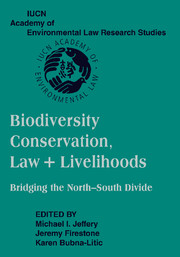 Biodiversity Conservation, Law and Livelihoods: Bridging the North-South Divide
Biodiversity Conservation, Law and Livelihoods: Bridging the North-South Divide Published online by Cambridge University Press: 31 July 2009
INTRODUCTION
The theoretical proposition of this work is to examine how the different degrees of environmental degradation, coupled with economic development, present in Brazil and the United States today, basically result from the different strategies adopted by each country regarding the occupation of their territories through the disposal of their public lands. In order to proceed with the comparison, some common ground needs to be established.
One of the first aspects to point out is the similarity in terms of time: before their separate colonization processes began, Brazil and the United States were no more than two vast lands, replete with natural resources. Moreover, although not environmentally friendly according to today's patterns, the practices of the indigenous peoples that originally inhabited the two lands did not exert a significant impact on their ecosystems. In both cases, it was only the arrival of the Europeans that led to significant changes in the environment.
By contrast, it is incontestable that once the first generation of settlers had established themselves in each country, their future independence would be a historical inevitability, as indeed has been the case for every other land subjected to the global colonisation process that started at the end of the fifteenth century. This perspective helps to demonstrate that, at least at one remote point in time, the two countries were perfectly equivalent, that is, to use a modern concept, they were just two developing nations, both in the institutional and in the economic sense.
To save this book to your Kindle, first ensure [email protected] is added to your Approved Personal Document E-mail List under your Personal Document Settings on the Manage Your Content and Devices page of your Amazon account. Then enter the ‘name’ part of your Kindle email address below. Find out more about saving to your Kindle.
Note you can select to save to either the @free.kindle.com or @kindle.com variations. ‘@free.kindle.com’ emails are free but can only be saved to your device when it is connected to wi-fi. ‘@kindle.com’ emails can be delivered even when you are not connected to wi-fi, but note that service fees apply.
Find out more about the Kindle Personal Document Service.
To save content items to your account, please confirm that you agree to abide by our usage policies. If this is the first time you use this feature, you will be asked to authorise Cambridge Core to connect with your account. Find out more about saving content to Dropbox.
To save content items to your account, please confirm that you agree to abide by our usage policies. If this is the first time you use this feature, you will be asked to authorise Cambridge Core to connect with your account. Find out more about saving content to Google Drive.